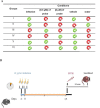Fluorescence In Vivo Hybridization (FIVH) for Detection of Helicobacter pylori Infection in a C57BL/6 Mouse Model
- PMID: 26848853
- PMCID: PMC4743915
- DOI: 10.1371/journal.pone.0148353
Fluorescence In Vivo Hybridization (FIVH) for Detection of Helicobacter pylori Infection in a C57BL/6 Mouse Model
Abstract
Introduction: In this study, we applied fluorescence in vivo hybridization (FIVH) using locked nucleic acid (LNA) probes targeting the bacterial rRNA gene for in vivo detection of H. pylori infecting the C57BL/6 mouse model. A previously designed Cy3_HP_LNA/2OMe_PS probe, complementary to a sequence of the H. pylori 16S rRNA gene, was used. First, the potential cytotoxicity and genotoxicity of the probe was assessed by commercial assays. Further, the performance of the probe for detecting H. pylori at different pH conditions was tested in vitro, using fluorescence in situ hybridization (FISH). Finally, the efficiency of FIVH to detect H. pylori SS1 strain in C57BL/6 infected mice was evaluated ex vivo in mucus samples, in cryosections and paraffin-embedded sections by epifluorescence and confocal microscopy.
Results: H. pylori SS1 strain infecting C57BL/6 mice was successfully detected by the Cy3_HP_LNA/2OMe_PS probe in the mucus, attached to gastric epithelial cells and colonizing the gastric pits. The specificity of the probe for H. pylori was confirmed by microscopy.
Conclusions: In the future this methodology can be used in combination with a confocal laser endomicroscope for in vivo diagnosis of H. pylori infection using fluorescent LNA probes, which would be helpful to obtain an immediate diagnosis. Our results proved for the first time that FIVH method is applicable inside the body of a higher-order animal.
Conflict of interest statement
Figures









Similar articles
-
Towards Fluorescence In Vivo Hybridization (FIVH) Detection of H. pylori in Gastric Mucosa Using Advanced LNA Probes.PLoS One. 2015 Apr 27;10(4):e0125494. doi: 10.1371/journal.pone.0125494. eCollection 2015. PLoS One. 2015. PMID: 25915865 Free PMC article.
-
Detection of Helicobacter pylori in the Gastric Mucosa by Fluorescence In Vivo Hybridization.Methods Mol Biol. 2017;1616:137-146. doi: 10.1007/978-1-4939-7037-7_8. Methods Mol Biol. 2017. PMID: 28600766
-
Hybridization-based detection of Helicobacter pylori at human body temperature using advanced locked nucleic acid (LNA) probes.PLoS One. 2013 Nov 22;8(11):e81230. doi: 10.1371/journal.pone.0081230. eCollection 2013. PLoS One. 2013. PMID: 24278398 Free PMC article.
-
Clinical role and importance of fluorescence in situ hybridization method in diagnosis of H pylori infection and determination of clarithromycin resistance in H pylori eradication therapy.World J Gastroenterol. 2007 Feb 7;13(5):671-5. doi: 10.3748/wjg.v13.i5.671. World J Gastroenterol. 2007. PMID: 17278188 Free PMC article. Review.
-
Adherence of Helicobacter pylori to the gastric mucosa.Can J Gastroenterol. 1997 Apr;11(3):243-8. doi: 10.1155/1997/149734. Can J Gastroenterol. 1997. PMID: 9167032 Review.
Cited by
-
Liposome Delivery of Nucleic Acids in Bacteria: Toward In Vivo Labeling of Human Microbiota.ACS Infect Dis. 2022 Jul 8;8(7):1218-1230. doi: 10.1021/acsinfecdis.1c00601. Epub 2022 Jun 23. ACS Infect Dis. 2022. PMID: 35737929 Free PMC article.
-
Spectral imaging and nucleic acid mimics fluorescence in situ hybridization (SI-NAM-FISH) for multiplex detection of clinical pathogens.Front Microbiol. 2022 Sep 29;13:976639. doi: 10.3389/fmicb.2022.976639. eCollection 2022. Front Microbiol. 2022. PMID: 36246234 Free PMC article.
-
An Introduction to Fluorescence in situ Hybridization in Microorganisms.Methods Mol Biol. 2021;2246:1-15. doi: 10.1007/978-1-0716-1115-9_1. Methods Mol Biol. 2021. PMID: 33576979
-
Application of Nucleic Acid Mimics in Fluorescence In Situ Hybridization.Methods Mol Biol. 2021;2246:69-86. doi: 10.1007/978-1-0716-1115-9_5. Methods Mol Biol. 2021. PMID: 33576983
-
Optimizing locked nucleic acid/2'-O-methyl-RNA fluorescence in situ hybridization (LNA/2'OMe-FISH) procedure for bacterial detection.PLoS One. 2019 May 31;14(5):e0217689. doi: 10.1371/journal.pone.0217689. eCollection 2019. PLoS One. 2019. PMID: 31150460 Free PMC article.
References
-
- Peek RM Jr., Blaser MJ (2002) Helicobacter pylori and gastrointestinal tract adenocarcinomas. Nat Rev Cancer 2: 28–37. - PubMed
Publication types
MeSH terms
Substances
LinkOut - more resources
Full Text Sources
Other Literature Sources
Medical
Research Materials
Miscellaneous

